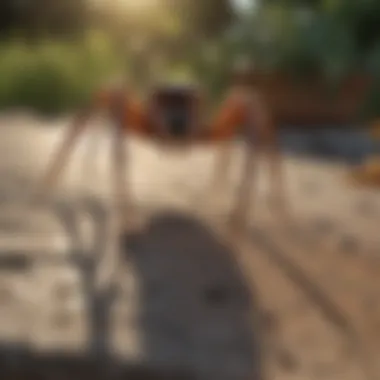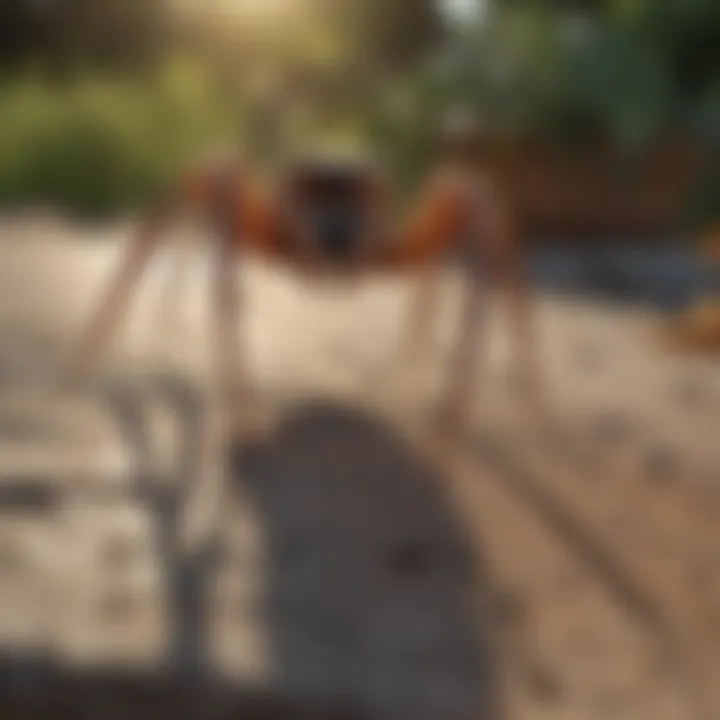Top Outdoor Sprays for Spider Control: A Comprehensive Guide


Intro
Managing spider populations around your home can feel like an uphill battle. Many homeowners see these eight-legged creatures as a nuisance rather than a benefit. Spiders can help control other pests, but when their population grows too high, or they venture too close for comfort, it's certainly time for action. Understanding the nature of spiders, how they thrive, and the options available for controlling them can empower you to maintain a safe and comfortable environment.
In this guide, we are diving deep into the best outdoor sprays for spiders. So, whether you’re dealing with the clumsy garden spider or the more menacing wolf spider, we’ve got you covered. We’ll begin with pest identification, helping you recognize the common spiders that invade our yards and homes. From there, we’ll explore prevention strategies, backed by practical home maintenance tips and natural deterrents. Finally, we’ll detail treatment options, comparing chemical and natural remedies so you can choose a path that aligns with your values and priorities.
Foreword to Spider Management
Effective spider management is crucial for maintaining a comfortable and safe outdoor environment around our homes. While many may see spiders as benign creatures, their presence can evoke unease. Understanding how to properly manage spider populations is key—not just for home aesthetics, but for safety as well. Managing these eight-legged visitors starts with recognizing their habits and habitats, which sets the stage for effective intervention strategies.
When we think of pest control, sprays often spring to mind. However, it's important to consider their usage carefully. Selecting the right product—be it a chemical or natural spray—can make a world of difference in not only managing spider populations but also ensuring the safety of the ecosystem around your home.
Understanding Spiders in the Outdoor Environment
Spiders are an integral part of our outdoor ecosystem, serving as natural pest controllers by feeding on insects. They prefer secluded spots like under leaves or in corners of porches. By observing their behavior, home owners can understand where they are likely to congregate and how to prevent them from establishing themselves too closely. It’s also useful to note that different species of spiders have different ecological roles and behaviors. For instance, the common garden spider often weaves webs in prominent locations, while the wolf spider might be lurking under rocks or logs.
In trying to keep spiders at bay, homeowners should not solely focus on elimination, but rather understand the balance of the ecosystem. This could mean accepting that a few spiders may be beneficial, while focusing efforts on controlling species known for bites or excessive webbing.
The Role of Sprays in Spider Control
When it comes to spider control, sprays serve as a practical solution for many homeowners. Utilizing sprays designed for outdoor use offers a two-fold approach: immediate deterring of existing spiders and protecting against future infestations. Different sprays have unique mechanisms, whether they disrupt the spider's central nervous system or create a repellent barrier that makes the environment less inviting.
However, before reaching for the spray can, homeowners should consider the specific needs of their environment. Some sprays include chemical ingredients that can pose risks to pets and beneficial insects, which is why understanding the product label and active ingredients is essential. Moreover, employing sprays is just one piece of the puzzle. Combining spray application with preventive measures such as sealing cracks and controlling moisture can bolster overall effectiveness in managing spider populations.
In spider management, knowledge is not just power; it’s safety. Understanding the outdoor environment and the specific needs of surrounds can guide effective use of sprays without harming beneficial species.
Types of Outdoor Sprays for Spiders
When it comes to tackling spiders around your home, understanding the various types of outdoor sprays available is crucial. Not only does the choice of spray matter, but knowing when and how to use these products can significantly affect their effectiveness. Selecting the right spray can mean the difference between a spider-free backyard and a creepy-crawly nightmare. In this section, we’ll delve into two broad categories of sprays – chemical sprays and natural alternatives – analyzing their benefits and considerations.
Chemical Sprays: An Overview
Chemical sprays have long been a common choice for homeowners looking to eliminate spider populations swiftly. These products typically contain synthetic pesticides that are designed to kill spiders on contact or provide a residual effect that prevents future infestations. Pyrethroids, for example, are a class of chemicals derived from the chrysanthemum flower. They work by targeting the nervous system of insects, leading to their quick demise upon contact.
While these sprays can be highly effective, it’s essential to read labels carefully. Understanding the active ingredients and their toxicity levels can help you make an informed choice. Some sprays are specifically formulated for outdoor use, ensuring that they can withstand environmental conditions. However, it's also important to consider the impact these chemicals may have on beneficial insects and the surrounding ecosystem.
When using chemical sprays, consider the following points:
- Speed of Action: Many chemical sprays act quickly, giving instant results.
- Residual Control: Some products can keep working for weeks or even months after application.
- Target Specificity: Certain sprays are designed to target a wide range of pests, including spiders.
"Chemical solutions can change the game in spider management, but meter your application based on the environment around you – it’s not one-size-fits-all!"
Natural Alternatives: Efficacy and Safety
Natural sprays have gained popularity in recent years, thanks to their perceived safety and eco-friendliness. These alternatives often utilize plant-based ingredients such as essential oils to deter spiders rather than eliminate them outright. For instance, peppermint and lemon oils are known for their strong scents that repel not just spiders but many other pests too.
When considering natural sprays, several aspects come into play. While they might not kill on contact like their chemical counterparts, their ability to create a hostile environment for spiders is their main advantage. Homeowners might also appreciate that these options pose less risk to pets and children, making them a favored choice among families.
However, some drawbacks should be noted:
- Shorter Duration: Natural sprays may need more frequent reapplication compared to chemical ones.
- Effectiveness Variability: The efficacy of natural ingredients can vary significantly, depending on the concentration and individual spider species.
- Preparation Time: DIY recipes can take time and experimentation to get just right.


In summary, the choice between chemical and natural sprays for spider control ultimately hinges on personal preferences, desired results, and the unique environment of your home. In the following sections, we’ll take a closer look at specific products within each category, so you can make the best informed decision for your unique situation.
Recommended Chemical Sprays
Knowing which chemical sprays are effective in keeping spiders away is crucial for homeowners hoping to maintain a spider-free environment. Chemical sprays can provide immediate relief and long-lasting protection against these creep crawlers. The goal here is not only to eliminate existing spider populations but also to deter new ones from taking residence in your backyard or garden. The right choice of spray can make a significant difference in your pest control efforts, blending effectiveness with safety.
Insecticides with Active Ingredients
Pyrethroids
When it comes to spider control, pyrethroids are often the go-to choice for various homeowners. These synthetic chemicals mimic the natural insecticides derived from Chrysanthemum flowers. One of the key features of pyrethroids is their fast-acting nature. They work by attacking the nervous system of spiders and other insects, leading to quick elimination.
Their popularity stems from their effectiveness against a wide variety of pests, not just spiders. They can be applied in many outdoor settings, making them versatile. However, there are considerations to keep in mind. While they offer rapid action, they also break down quickly in sunlight, which means reapplication might be necessary in sunny areas.
Additionally, the safety profile of pyrethroids should not be overlooked. They can affect non-target beneficial insects. Homeowners should always read labels carefully and follow safety precautions to minimize risks to surrounding ecosystems.
Neonicotinoids
On the other hand, neonicotinoids have carved a niche in the pest control industry. These chemicals are designed to mimic nicotine and affect the insect's nervous system, resulting in paralysis and death. What sets neonicotinoids apart is their substantial residual activity. After application, they continue to work over an extended period, reducing the need for frequent reapplication.
However, there is growing concern about their impact on non-target species, particularly pollinators like bees. This has prompted many homeowners to weigh the pros and cons of using these chemicals. Although effective against spiders, communities are increasingly cautious about neonicotinoids due to potential ecological consequences. For those considering these products, it would be wise to balance effectiveness with environmental impact.
Dual-Action Products
In the realm of spider control, dual-action products combine multiple active ingredients to tackle pest problems from different angles. These products are designed to provide both immediate knockdown and prolonged protection, making them particularly appealing to homeowners who want a "set-it-and-forget-it" solution.
For instance, a dual-action spray might contain both a fast-acting insecticide to quickly eliminate spiders on contact while also incorporating a long-lasting agent to prevent re-infestation. This multifaceted approach can lead to better outcomes in pest control, ensuring your outdoor spaces remain spider-free for extended periods. Homeowners often find that such products provide excellent value for money, as they can reduce the frequency of applications needed.
In summary, when selecting chemical sprays for spider management, consider the unique pros and cons of both pyrethroids and neonicotinoids, and explore the dual-action options that offer comprehensive solutions to common pest woes.
Popular Natural Sprays
When it comes to keeping your outdoor spaces spider-free, natural sprays hold their own against harsh chemical options. Many homeowners nowadays look for environmentally friendly alternatives to manage unwanted pests. Natural sprays are not only effective but also safer for pets and children, making them a compelling option for residences where safety is a priority. These sprays harness the power of nature to deter spiders, often with ingredients found right in your kitchen or garden.
Natural sprays can serve multiple functions, such as acting as a preventive measure and offering a pleasant aroma. However, they aren't without their considerations. Their efficacy may depend on certain factors like weather conditions, the type of spiders you're dealing with, and how often the spray is applied. In short, opting for natural sprays can be both a favorable and responsible choice for spider control.
Essential Oils for Spider Deterrence
Peppermint Oil
Peppermint oil is often hailed as a star player when it comes to repelling spiders. This essential oil boasts a potent smell that many find invigorating, while spiders are known to dislike it. Its effectiveness lies not only in its aroma but also in its ability to break down spider pheromones, which can disrupt their natural behaviors. This disruption can lead to fewer spider sightings, making your outdoor space more enjoyable.
The fresh fragrance of peppermint oil makes it a popular choice for many homeowners. It's beneficial for repelling spiders, and you might also enjoy it in your home as it doubles up as a room freshener. One unique feature of peppermint oil is its cooling sensation, which many people may find soothing. However, it's worth noting that undiluted peppermint oil can be strong and may cause irritation if it comes in direct contact with the skin, so caution is necessary.
Lemon Oil
Lemon oil, with its zesty aroma, is another essential oil that serves well in the pursuit of spider control. This oil emits a scent that is not only refreshing but also acts as a natural insect repellent. What sets lemon oil apart is its high acidity level, which can disrupt the environment that spiders thrive in. Just like peppermint, the scent of lemon oil works to mask spider pheromones, making it less likely for them to hang around.
Highlighting its key characteristic: lemon oil’s ability to blend well with many other scents, making it versatile for various DIY recipes. With its properties, lemon oil can zap away your worries about spiders while leaving your area smelling like a sunlit grove. However, one must keep in mind that lemon oil can also have bleaching effects on fabrics and surfaces, so testing it on a small area is advisable before applying it widely.
DIY Natural Spray Recipes
For those who enjoy a hands-on approach, crafting your own natural sprays can be both fun and satisfying. Here are a couple of simple recipes to get you started:


- Peppermint Blast
- Ingredients:
- 1 cup water
- 10 drops peppermint oil
elements like vinegar or dish soap can also be added if you desire an extra boost. Just mix all ingredients in a spray bottle and shake well before each use.
- Citrus Shield
- Ingredients:
- 1 cup water
- 10 drops lemon oil
This easy formula can be sprayed around doorways and windowsills to deter spider activity, giving you both a fresh scent and a pest-free zone.
Application Techniques for Outdoor Sprays
When it comes to effectively managing spider populations in and around your home, the application of outdoor sprays cannot be taken lightly. It’s about more than just spraying chemicals or natural substances; it requires understanding the right timing and methods to ensure that your efforts yield the best results.
Choosing the Right Timing
Timing can make or break your spider management strategy. Spraying too early or too late might result in spiders still haunting your patio or garden. Early spring, when many spiders are emerging from their winter hiding spots, is crucial. Applying your spray during this time can dramatically reduce their presence before they set up shop. Additionally, consider the weather conditions.
Wind and rain can affect the efficacy of your sprays. A gusty day could carry your spray away from its intended target, while rain might wash it away entirely. Therefore, aim for a day that is calm and dry for optimal results. Remember, it’s not just about dousing the area; it’s about being strategic.
Methods of Application
Spraying Strategies
Spraying strategies hinge upon how you deploy the product for maximum effect. Utilizing a spray nozzle that allows for fine mist application can be quite effective. Unlike a standard attachment, a fine mist ensures greater coverage and reduces the likelihood of wasted product. This method allows for even distribution, reaching those tight corners and crevices where spiders love to hide.
Moreover, employing zone spraying can target specific areas where spider activity is high. This form of application is beneficial as it conserves product while boosting effectiveness. Instead of spraying everything indiscriminately, you zero in on hotspots like porch eaves, window frames, and corners of garages. A memorable point here is that less can indeed be more, especially if targeted wisely.
Target Areas for Maximum Effectiveness
Identifying target areas for maximum effectiveness is crucial in this endeavor. Spiders are often found in dark and undisturbed places, so turning your attention toward those spots will be of utmost importance.
Common hideouts include:
- Underneath furniture on decks and patios
- In shrubs and flower beds close to the home
- Around doorways or windows where entry is easy
Focusing on these key areas can greatly enhance your spray’s efficiency. Another smart move is to observe spider behavior before application—if you see webs forming in certain spots, that’s basically a neon sign pointing to where you should apply your spray.
Evaluating Spray Effectiveness
Evaluating the effectiveness of outdoor sprays for spiders is a crucial step in pest management that often gets overlooked. Many homeowners might pick a spray based on its brand reputation or eye-catching packaging rather than its actual effectiveness against spiders. Understanding the nuances of spray performance can save you time, effort, and potentially money in the long run. It’s about picking products that will not only tackle your immediate spider situation but also prevent future invasions.
Measuring effectiveness involves considering several factors: active ingredients, application methods, and environmental impact. The right choice hinges not only on immediate results but also on the safety and longevity of the product you choose. More than just eradication, it's about creating an unfriendly environment for spiders, ensuring they won't return anytime soon.
Understanding Product Labels
Product labels are akin to a roadmap that guides you through the intricacies of what you're buying. Often, these labels contain vital information regarding the composition of sprays, usage instructions, and safety precautions. When assessing a product, one should pay close attention to the active ingredients. Many sprays boast active compounds like pyrethroids or neonicotinoids. Understanding these can inform you on how effective the spray will be against specific spider types.


Moreover, labels include information about
- Application Rate: How much product should be used per square foot.
- Target Pests: Not all sprays are effective against all spider species. For instance, if you're dealing with black widows, ensure the spray is labeled for that species.
- Reentry Time: This detail tells you how long you should wait before re-entering the treated area after application.
Being armed with this knowledge means that you won’t be left high and dry with a product that can’t meet your needs. One glaring misstep could lead to sparking a reign of spiders in your home instead of deterring them.
User Experiences and Reviews
Listening to the voice of fellow users can illuminate the path to effective spider management. User experiences and reviews are rich stashes of real-world insights that can make or break your choice. They can provide information on longevity, effectiveness, and ease of application that goes beyond what’s listed on the product label.
Consider checking user testimonials on sites like Reddit or specialist pesticide forums. They often reveal insights such as:
- Real-world effectiveness: How well did the spray work against spiders, especially in various environments?
- Application ease: Was the product easy to apply, or did users find themselves in a sticky situation?
- Reoccurrence of spiders: Did users see spiders returning shortly after application, or did long-lasting results occur?
This feedback can help you avoid products that promise the moon but deliver little. You can use the experiences of others as a powerful ally to make informed, educated decisions that lead to a spider-free area.
"A stitch in time saves nine," they say. Investing time in evaluating your options can prevent bigger issues down the line.
In summary, fully understanding product labels and diving into user reviews can equip you with the tools necessary to make an intelligent choice when selecting outdoor sprays for spider management. Your informed decisions can lead to a peace of mind and a home less likely to house unwelcome eight-legged guests.
Environmental Considerations
When it comes to managing spider populations outdoors, it’s crucial to take a step back and assess the potential impacts of the methods we choose. In this guide, we understand that every spray product, be it chemical or natural, carries implications not just for the immediate area but for surrounding wildlife, plants, and even the air we breathe. This section delves into the core reasons why considering the environment is paramount when selecting an outdoor spider spray.
Impacts of Chemical vs. Natural Sprays
Chemical sprays are often effective, no doubt. However, they can act like a double-edged sword. While they may zap those unwanted eight-legged guests faster than you can say "boo!", they might also leave behind a trail of effects that linger far longer than intended.
- Non-Selective Action: These sprays don’t just target spiders; they often take down beneficial insects as well, disrupting the balance of the local ecosystem. This could mean fewer pollinators and pest controllers, leading to potential new problems down the line.
- Residue Concerns: Many chemical sprays leave residues that can wash away during rainstorms. The runoff can find its way into local waterways, impacting fish and other aquatic life.
- Biodiversity: Using heavy chemicals can reduce the biodiversity of the flora and fauna in your yard. A garden thriving with life can quickly turn into a sterile environment.
On the other hand, natural sprays, with their plant-based ingredients, often aim to minimize negative environmental impact:
- Targeted Action: Many natural options focus on repelling rather than killing spiders, allowing beneficial insects to thrive.
- Decomposition: Natural ingredients often break down quicker and contribute back to the soil, which is a win for the ecosystem.
- Less Toxicity: They generally pose lower risks to pets and humans, scratching that peace-of-mind itch many homeowners have when treating their yards.
Ultimately, homeowners must weigh the effectiveness of these sprays against their long-term environmental impacts. Having a few spiders around may also bolster a natural balance, as they can prey on other pests. Asking yourself, "Is this spray more trouble than it's worth?" could ultimately save both the local ecosystem and your peace.
Safety Precautions for Ecosystems
When applying any form of outdoor spray, keeping the ecosystem safe should be your top priority. Here are some key precautions every homeowner should consider:
- Know the Product: Familiarizing yourself with the ingredients in your chosen spray can help you avoid harmful substances. Look for eco-conscious certifications or research any unfamiliar terms on the label.
- Targeted Application: Aim at the specific areas where spiders are unwelcome rather than blanket spraying your garden. This reduces the risk of affecting non-target species.
- Environmental Conditions: Avoid spraying before rain or windy days. Not only can this dilute the product, but it can also cause it to drift to unintended areas, harming other habitats.
- Timing Matters: Early morning or late afternoon can be the best for application. Temperatures are cooler, and beneficial insects are less active.
- Protecting Wildlife: Consider creating buffer zones. For instance, keep your sprays away from flowering plants that attract bees and other pollinators.
By taking these precautions, you can ensure that your battle against spiders does not inadvertently harm the vibrant ecosystem that surrounds your home.
Closure and Final Recommendations
Managing spider populations effectively requires a blend of knowledge and action. In this guide, we’ve delved into various sprays, both chemical and natural, that can help create a less spider-friendly environment around your home. With an understanding of spider behavior and habitats, homeowners can implement targeted strategies that align well with their specific needs. This article serves as a comprehensive resource to empower you, the reader, to make informed choices in spider management.
Key Takeaways on Spider Management
- Know Your Enemy: Understanding the specific types of spiders that frequent your area can influence your choice of sprays. Not all sprays affect every spider species equally.
- Product Awareness: Always review product labels carefully. Knowledge of active ingredients will help you judge both effectiveness and safety.
- Natural vs. Chemical: If environmental impact is a significant concern for you, remember that natural sprays may be less harmful but could require more frequent applications.
- Timing is Everything: Proper application timing matters. Spraying during the early morning or late evening when spiders are most active can improve the effectiveness of your chosen products.
Next Steps for Homeowners
After gaining insight from this guide, homeowners can take action by:
- Assessing Your Yard: Walk around your property and note down areas where you've seen spider activity. This will help you devise a targeted spray plan tailored to your needs.
- Choosing Your Spray: Based on your knowledge and consideration of environmental factors, select the product that best suits your situation—whether it be a robust chemical spray or a natural alternative.
- Scheduling Regular Treatments: Don't treat spider management as a one-off task. Establish a regular maintenance routine; after all, prevention is often easier than elimination.
- Educating Yourself Continuously: Keep up-to-date with new products, emerging spider behaviors, and innovative management techniques by consulting reliable sources like Wikipedia, Britannica, or community forums like Reddit.
By taking these steps, you not only enhance your home’s comfort but also contribute to a safer and more balanced ecosystem.



